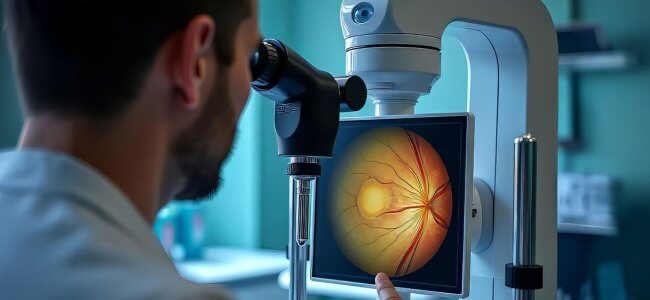Perceptual Learning and visual rehabilitation of the visually impaired patient

Causes and impact of low vision
Low vision is a condition that involves a significant reduction in visual acuity that cannot be corrected through the use of glasses, contact lenses or surgery. There can be many causes, including:
- age-related macular degeneration (a condition that is the leading cause of low vision in the Western world today)
- diabetic retinopathy
- glaucoma
- hereditary retinal dystrophies
- neurological impairments secondary to brain trauma or ischemia
A visual impairment can profoundly affect the quality of life of the person suffering from it, hindering daily activities such as reading, writing, face recognition, orientation and mobility in space.
Neuronal Plasticity and Perceptual Learning
In recent decades, neuroscience has shown that the human brain maintains a certain level of plasticity even in adulthood. This prerogative allows, for example, visually impaired patients to improve their perceptual abilities either through spontaneous adaptation or through specific visual rehabilitation programs that can guide and influence this mechanism1.
Piero Angela introduces the concepts of brain plasticity for rehabilitation of children and adults.
One of the mechanisms underlying this phenomenon takes the name of perceptual learning2, a process by which repeated exposure to certain stimuli can condition and thus optimize the ability of the visual system to process stimuli from the environment more effectively.
Perceptual learning applied to visual rehabilitation is thus a sensory learning process3 that can lead to improvements in visual performance through repeated training with specific visual stimuli.
In essence, this phenomenon is based on the idea that following partial impairment of visual function, the system is able to adapt allowing for an enhancement of residual abilities.
Rehabilitation strategies and future prospects
Studies on perceptual learning attach great importance to the type of visual stimulus adopted5. There is specificity related to the proposed stimulus, i.e., correlated improvements can be expected primarily for the type of skill for which the patient is training.
For example, those who practice detail perception of still images may not automatically show improvement in viewing moving objects.
Perceptual improvements would be associated with functional changes in the visual cortex and other brain areas involved in image processing4 (so-called neuronal plasticity).
Perceptual learning would thus be made possible by a certain gradient of plasticity in the visual system. In fact, scientific studies have shown that perceptual training can involve different mechanisms at the neuronal level depending on the pathology causing low vision and the type of resulting damage.
In the presence of a central scotoma (an area of non-vision located in the center of the visual field), as in the case of age-related macular degeneration, the brain can reorganize itself by learning to use a specific area adjacent to the scotoma (peripheral retinal locus) to make up for the missing retinal region to better observe images.
There is also a theory that, through training and repeated neuronal coactivation, the neurons responsible for processing certain visual stimuli may become more efficient, allowing the subject to perceive details that he or she previously could not distinguish.
A further induced phenomenon is related to the possible enhancement of multisensory integration. In visually impaired patients, the brain may optimize access to and integration of information from other senses, such as touch or hearing, to compensate for reduced visual input.
There are numerous scientific studies that attribute possible enhancements of visual abilities to perceptual learning.
As mentioned, in cases of age-related macular degeneration, resulting in loss of central vision, targeted exercises can help the patient stabilize eccentric phyisation to make better use of an area adjacent to the injured area to observe details.
Rehabilitation programs based on low-contrast stimuli have also been proposed to help improve this ability, which is reflected in the ease of distinguishing, for example, objects from the background3.
Exercises can also be aimed at improving the speed of detecting lateral stimuli6–13, processing particular images as well as increasing speed and accuracy in reading.
Training that supports rehabilitation can make use of a variety of both high- and low-tech tools.
Certainly, the advent of new technologies also supported by artificial intelligence makes it possible to achieve greater control of the activity performed and to extend training at home when possible, with definite advantages in terms of continuity of treatment.
Expected outcomes and individual factors
When talking about visual rehabilitation and possible expected outcomes, it is necessary to remember some aspects that in a sense pose a challenge to the rehabilitator. There is individual variability, that is, not all patients respond in the same way to perceptual training: age, severity of low vision, and patient motivation may be determining factors.
The ultimate goal is to transfer the skills learned into benefits in daily life; sometimes specific aids are needed to facilitate this transition.
The length of training needed may vary from person to person and must be constant.
The persistence of the benefits obtained through training may depend on several factors, including the pathology causing the visual impairment (presence of degenerative disease with a progressive course) and the patient’s ability to remain active by continuing to apply the skills learned in performing activities of daily living.
Bibliography
- Passamonti C, Frissen I, Làdavas E. Visual recalibration of auditory spatial perception: two separate neural circuits for perceptual learning. Eur J Neurosci. 2009 Sep;30(6):1141-50. doi: 10.1111/j.1460-9568.2009.06910.x. Epub 2009 Sep 4. PMID: 19735289.
- Chung ST, Legge GE, Cheung SH. Letter-recognition and reading speed in peripheral vision benefit from perceptual learning. Vision Res. 2004 Mar;44(7):695-709. doi: 10.1016/j.visres.2003.09.028. PMID: 14751554; PMCID: PMC2729075.
- Chung ST, Li RW, Levi DM. Learning to identify near-acuity letters, either with or without flankers, results in improved letter size and spacing limits in adults with amblyopia. PLoS One. 2012;7(4):e35829. doi: 10.1371/journal.pone.0035829. Epub 2012 Apr 30. PMID: 22558234; PMCID: PMC3340394.
- Polat, U. (2009). Perceptual learning induces neuroplasticity, enabling improvement of visual functions. Expert Review of Ophthalmology, 4(6), 573–576. https://doi.org/10.1586/eop.09.54.
- Frank SM, Reavis EA, Tse PU, Greenlee MW. Neural mechanisms of feature conjunction learning: enduring changes in occipital cortex after a week of training. Hum Brain Mapp. 2014 Apr;35(4):1201-11. doi: 10.1002/hbm.22245. Epub 2013 Feb 18. PMID: 23418123; PMCID: PMC6869163.
- Bolognini N., Rasi F., Làdavas E. Visual localization of sounds, Neuropsychologia. Volume 43, Issue 11, 2005, Pages 1655-1661, ISSN 0028-3932. doi: 10.1016/j.neuropsychologia.2005.01.015.
- Nadia Bolognini, Fabrizio Rasi, Michela Coccia, Elisabetta Làdavas, Visual search improvement in hemianopic patients after audio-visual stimulation, Brain, Volume 128, Issue 12, December 2005, Pages 2830–2842. doi: 10.1093/brain/awh656.
- Fabrizio Leo, Nadia Bolognini, Claudia Passamonti, Barry E. Stein, Elisabetta Làdavas, Cross-modal localization in hemianopia: new insights on multisensory integration, Brain, Volume 131, Issue 3, March 2008, Pages 855–865. doi: 10.1093/brain/awn003.
- Claudia Passamonti, Caterina Bertini, Elisabetta Làdavas. Audio-visual stimulation improves oculomotor patterns in patients with hemianopia. Neuropsychologia, Volume 47, Issue 2, 2009, Pages 546-555, ISSN 0028-3932. doi: 10.1016/j.neuropsychologia.2008.10.008.
- Tinelli, F., Purpura, G., & Cioni, G. (2015). Audio-Visual Stimulation Improves Visual Search Abilities in Hemianopia due to Childhood Acquired Brain Lesions. Multisensory Research, 28(1-2), 153-171. doi: 10.1163/22134808-00002484.
- Làdavas, E., Tosatto, L., & Bertini, C. (2020). Behavioural and functional changes in neglect after multisensory stimulation. Neuropsychological Rehabilitation, 32(5), 662–689. doi: 10.1080/09602011.2020.1786411.
- Zigiotto, L., Damora, A., Albini, F., Casati, C., Scrocco, G., Mancuso, M., Bolognini, N. (2020). Multisensory stimulation for the rehabilitation of unilateral spatial neglect. Neuropsychological Rehabilitation, 31(9), 1410–1443. doi: 10.1080/09602011.2020.1779754.
- Neurovisual Training With Acoustic Feedback: An Innovative Approach for Nystagmus Rehabilitation. Antognetti, Damiano et al. Archives of Rehabilitation Research and Clinical Translation, Volume 6, Issue 4, 100371. doi: 10.1016/j.arrct.2024.100371.
Talk to a visual rehabilitation specialist now
Contact us without obligation to receive information.
Our Specialists will respond to you Monday through Friday from 9:00 a.m. to 5:00 p.m. (CET).

You are free to reproduce this article but you must cite: emianopsia.com, title and link.
You may not use the material for commercial purposes or modify the article to create derivative works.
Read the full Creative Commons license terms at this page.
You may also be interested in...

Nystagmus and Audiovisual Stimulation: a new approach in Neurorehabilitation
The Italian experience of the Neurorehabilitation Unit, Azienda Ospedaliera Universitaria Pisana, confirms that multisensory stimulation represents an innovative rehabilitation option that can promote real and lasting improvements in the management of nystagmus and other ocular motility alterations.

